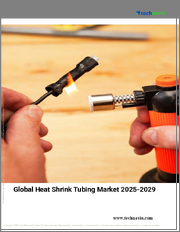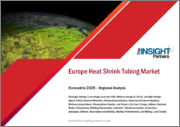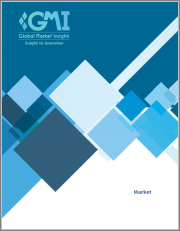
|
시장보고서
상품코드
1591783
열수축 튜브 시장 : 전압, 재료, 최종 사용자별 - 세계 예측(2025-2030년)Heat-Shrink Tubing Market by Voltage (High Voltage, Low Voltage, Medium Voltage), Material (Ethylene Tetrafluoroethylene, Fluorinated Ethylene Propylene, Perfluoroalkoxy Alkane), End User - Global Forecast 2025-2030 |
||||||
열수축 튜브 시장은 2023년에 21억 9,000만 달러로 평가되었습니다. 2024년에는 23억 1,000만 달러에 이를 것으로 예측되며, CAGR 5.75%로 성장하여 2030년에는 32억 4,000만 달러에 달할 것으로 예측됩니다.
열수축 튜브는 전선, 케이블 및 특정 자동차 부품을 보호하기 위해 주로 전기 응용 분야에서 사용되는 다용도 절연 및 보호 솔루션입니다. 튜브는 열에 노출되면 수축하는 열가소성 재질로 만들어져 커버하는 부품에 꼭 맞게 수축합니다. 열수축 튜브의 필요성은 기계적 손상, 습기, 마모 및 화학 물질의 침투를 차단하는 능력에서 비롯됩니다. 열수축 튜브는 자동차, 통신, 전자, 항공우주 및 기타 산업에서 일반적으로 전기 시스템의 수명과 최적의 성능을 보장하기 위해 사용됩니다. 최종 용도에는 다양한 산업, 상업 및 주거용 커넥터, 단자 및 접합부가 포함됩니다.
| 주요 시장 통계 | |
|---|---|
| 기준 연도(2023년) | 21억 9,000만 달러 |
| 예측 연도(2024년) | 23억 1,000만 달러 |
| 예측 연도(2030년) | 32억 4,000만 달러 |
| CAGR(%) | 5.75% |
시장 인사이트에 따르면, 열수축 튜브 시장의 성장은 주로 전기자동차의 신뢰할 수 있고 안전한 케이블 관리 시스템에 대한 수요 증가, 전자공학의 발전, 세계 통신 인프라의 확장에 의해 주도되고 있습니다. 또한, 태양광 및 풍력 발전과 같은 재생 가능 에너지 시스템에 대한 지원은 장비 보호를 위한 열수축 용도의 성장을 가속하고 있습니다. 최근 환경 인식 증가와 엄격한 규제에 힘입어 환경 친화적이고 할로겐이 없는 열수축 튜빙이 새로운 비즈니스 기회로 떠오르고 있습니다. 기업들은 지속 가능한 소재와 제조 공정에 대한 혁신과 투자를 통해 이러한 추세를 활용할 수 있습니다. 이러한 기회를 포착하기 위해서는 R&D 역량을 강화하고 기술 발전을 위한 전략적 파트너십을 구축하는 것이 좋습니다.
그러나 시장 확대는 원자재 가격 변동, 특히 환경 친화적인 대안에 대한 원자재 가격 변동, 냉수축 튜브 및 기타 첨단 소재와 같은 대체 단열 기술과의 치열한 경쟁과 같은 문제에 직면해 있습니다. 시장에서의 기술 혁신은 열수축 튜브의 내열성, 우수한 유연성, 열악한 조건에서의 내구성 향상과 같은 성능 특성을 향상시키기 위한 열수축 튜브의 개선에 초점을 맞출 수 있습니다. 따라서 나노 소재와 바이오 폴리머를 채택하면 시장을 선도할 수 있는 새로운 길을 열 수 있습니다. 전반적으로 열수축 튜브 시장의 특성은 역동적이고 진화하고 있으며, 기술 발전과 산업 응용 분야 증가로 인해 큰 성장 여지가 있습니다.
시장 역학: 빠르게 진화하는 열수축 튜브 시장의 주요 시장 인사이트 공개
열수축 튜브 시장은 수요 및 공급의 역동적인 상호작용에 의해 변화하고 있습니다. 이러한 시장 역학의 변화를 이해함으로써 기업은 정보에 입각한 투자 결정을 내리고, 전략적 의사결정을 정교화하며, 새로운 비즈니스 기회를 포착할 수 있습니다. 이러한 트렌드를 종합적으로 파악함으로써 기업은 정치적, 지리적, 기술적, 사회적, 경제적 영역 전반에 걸친 다양한 리스크를 줄일 수 있으며, 소비자 행동과 그것이 제조 비용 및 구매 동향에 미치는 영향을 보다 명확하게 이해할 수 있습니다.
- 시장 성장 촉진요인
- 전력 T& D 시스템 확장 및 업그레이드에 대한 정부 노력
- 세계 발전 용량 증가
- 시장 성장 억제요인
- 유독성 가스 배출에 대한 정부 규정
- 그레이마켓에서 저품질의 저렴한 제품을 구할 수 있습니다.
- 시장 기회
- 자동차 산업에서 열수축 튜브의 사용 증가
- 탈착식 열수축 튜브의 출현
- 시장 과제
- 열수축 튜브의 부적절한 설치
Portre's Five Forces: 열수축 튜브 시장 탐색을 위한 전략 도구
Portre's Five Forces 프레임워크는 시장 상황경쟁 구도를 이해하는 중요한 도구입니다. Portre's Five Forces 프레임워크는 기업의 경쟁력을 평가하고 전략적 기회를 탐색할 수 있는 명확한 방법을 제공합니다. 이 프레임워크는 기업이 시장 내 세력도를 평가하고 신규 사업의 수익성을 판단하는 데 도움이 됩니다. 이러한 통찰력을 통해 기업은 강점을 활용하고, 약점을 해결하고, 잠재적인 도전을 피하고, 보다 강력한 시장 포지셔닝을 확보할 수 있습니다.
PESTLE 분석 : 열수축 튜브 시장의 외부 영향 파악
외부 거시 환경 요인은 열수축 튜브 시장의 성과 역학을 형성하는 데 매우 중요한 역할을 합니다. 정치적, 경제적, 사회적, 기술적, 법적, 환경적 요인에 대한 분석은 이러한 영향을 탐색하는 데 필요한 정보를 제공하며, PESTLE 요인을 조사함으로써 기업은 잠재적인 위험과 기회를 더 잘 이해할 수 있습니다. 이러한 분석을 통해 기업은 규제, 소비자 선호도, 경제 동향의 변화를 예측하고 선제적이고 능동적인 의사결정을 내릴 준비를 할 수 있습니다.
시장 점유율 분석 열수축 튜브 시장에서경쟁 구도 파악
열수축 튜브 시장의 상세한 시장 점유율 분석을 통해 공급업체의 성과를 종합적으로 평가할 수 있습니다. 기업은 수익, 고객 기반 및 성장률과 같은 주요 지표를 비교하여 경쟁적 위치를 파악할 수 있습니다. 이 분석은 시장의 집중화, 단편화, 통합의 추세를 파악할 수 있으며, 공급업체는 치열한 경쟁 속에서 자신의 입지를 강화할 수 있는 전략적 의사결정을 내리는 데 필요한 통찰력을 얻을 수 있습니다.
FPNV 포지셔닝 매트릭스 열수축 튜브 시장에서 벤더의 성능 평가
FPNV 포지셔닝 매트릭스는 열수축 튜브 시장에서 공급업체를 평가할 수 있는 중요한 도구입니다. 이 매트릭스를 통해 비즈니스 조직은 벤더의 비즈니스 전략과 제품 만족도를 기반으로 평가하여 목표에 부합하는 정보에 입각한 의사결정을 내릴 수 있으며, 4개의 사분면으로 벤더를 명확하고 정확하게 세분화하여 전략 목표에 가장 적합한 파트너와 솔루션을 식별할 수 있습니다. 전략 목표에 가장 적합한 파트너와 솔루션을 식별할 수 있습니다.
열수축 튜브 시장에서 성공하기 위한 전략 분석 및 추천 열수축 튜브 시장에서의 성공 경로를 그리다.
열수축 튜브 시장 전략 분석은 세계 시장에서 입지를 강화하고자 하는 기업에게 필수적입니다. 주요 자원, 역량 및 성과 지표를 검토함으로써 기업은 성장 기회를 식별하고 개선할 수 있습니다. 이러한 접근 방식을 통해 경쟁 환경의 도전을 극복하고 새로운 비즈니스 기회를 활용하여 장기적인 성공을 거둘 수 있도록 준비할 수 있습니다.
이 보고서는 주요 관심 분야를 포괄하는 시장에 대한 종합적인 분석을 제공합니다.
1. 시장 침투도 : 현재 시장 환경의 상세한 검토, 주요 기업의 광범위한 데이터, 시장 도달 범위 및 전반적인 영향력 평가.
2. 시장 개척도: 신흥 시장에서의 성장 기회를 파악하고, 기존 분야의 확장 가능성을 평가하며, 미래 성장을 위한 전략적 로드맵을 제공합니다.
3. 시장 다각화 : 최근 제품 출시, 미개척 지역, 업계의 주요 발전, 시장을 형성하는 전략적 투자를 분석합니다.
4. 경쟁 평가 및 정보 : 경쟁 구도를 철저히 분석하여 시장 점유율, 사업 전략, 제품 포트폴리오, 인증, 규제 당국의 승인, 특허 동향, 주요 기업의 기술 발전 등을 검토합니다.
5. 제품 개발 및 혁신 : 미래 시장 성장을 가속할 것으로 예상되는 첨단 기술, 연구 개발 활동 및 제품 혁신을 강조합니다.
이해관계자들이 충분한 정보를 바탕으로 의사결정을 내릴 수 있도록 다음과 같은 중요한 질문에 대한 답변도 제공합니다.
1. 현재 시장 규모와 향후 성장 전망은?
2. 최고의 투자 기회를 제공하는 제품, 부문, 지역은?
3. 시장을 형성하는 주요 기술 동향과 규제의 영향은?
4. 주요 벤더의 시장 점유율과 경쟁 포지션은?
5.벤더 시장 진입 및 철수 전략의 원동력이 되는 수익원과 전략적 기회는 무엇인가?
목차
제1장 서문
제2장 조사 방법
제3장 주요 요약
제4장 시장 개요
제5장 시장 인사이트
- 시장 역학
- 성장 촉진요인
- 성장 억제요인
- 기회
- 과제
- 시장 세분화 분석
- Porter의 Five Forces 분석
- PESTEL 분석
- 정치
- 경제
- 사회
- 기술
- 법률
- 환경
제6장 열수축 튜브 시장 : 전압별
- 고전압
- 저전압
- 중전압
제7장 열수축 튜브 시장 : 소재별
- 에틸렌테트라플루오르에틸렌
- 불소화 에틸렌 프로파일렌
- 퍼플루오로 알콕시 알칸
- 폴리올레핀
- 폴리테트라플루오로에틸렌
제8장 열수축 튜브 시장 : 최종사용자별
- 자동차
- 화학제품
- 식품 및 음료
- 유틸리티
제9장 아메리카의 열수축 튜브 시장
- 아르헨티나
- 브라질
- 캐나다
- 멕시코
- 미국
제10장 아시아태평양의 열수축 튜브 시장
- 호주
- 중국
- 인도
- 인도네시아
- 일본
- 말레이시아
- 필리핀
- 싱가포르
- 한국
- 대만
- 태국
- 베트남
제112장 유럽, 중동 및 아프리카의 열수축 튜브 시장
- 덴마크
- 이집트
- 핀란드
- 프랑스
- 독일
- 이스라엘
- 이탈리아
- 네덜란드
- 나이지리아
- 노르웨이
- 폴란드
- 카타르
- 러시아
- 사우디아라비아
- 남아프리카공화국
- 스페인
- 스웨덴
- 스위스
- 터키
- 아랍에미리트(UAE)
- 영국
제12장 경쟁 구도
- 시장 점유율 분석, 2023
- FPNV 포지셔닝 매트릭스, 2023
- 경쟁 시나리오 분석
- 전략 분석과 제안
기업 리스트
- 3M Company
- ABB Ltd.
- Alpha Wire
- Assembly Fasteners, Inc.
- HellermannTyton
- Huizhou Guanghai Electronic Insulation Materials Co.,Ltd.
- Insultab, Inc. by Pexco LLC
- Jiangsu Dasheng Heat Shrinkable Material Co.,Ltd.
- Molex, LLC
- Qualtek Electronic Corporation
- Shenzhen Woer Heat-Shrinkable Material Co., Ltd.
- TE Connectivity
- Thermosleeve USA
- Yamuna Cable Accessories(P) Limited
- Zeus Company Inc.
The Heat-Shrink Tubing Market was valued at USD 2.19 billion in 2023, expected to reach USD 2.31 billion in 2024, and is projected to grow at a CAGR of 5.75%, to USD 3.24 billion by 2030.
Heat-shrink tubing is a versatile insulation and protection solution used primarily in electrical applications to protect wires, cables, and specific on-board components. The tubing is made of thermoplastic material that shrinks when exposed to heat, providing a snug fit over the components it covers. Its necessity stems from its ability to insulate against mechanical damage, moisture, abrasion, and chemical intrusion. Typically applied in industries such as automotive, telecommunications, electronics, and aerospace, heat-shrink tubing ensures the longevity and optimal performance of electrical systems. The end-use scope includes applications in connectors, terminals, and joints across various industrial, commercial, and residential settings.
| KEY MARKET STATISTICS | |
|---|---|
| Base Year [2023] | USD 2.19 billion |
| Estimated Year [2024] | USD 2.31 billion |
| Forecast Year [2030] | USD 3.24 billion |
| CAGR (%) | 5.75% |
Market insights reveal that the growth of the heat-shrink tubing market is primarily driven by the increased demand for reliable and safe cable management systems in electric vehicles, advancements in electronics, and the expansion of telecommunication infrastructures worldwide. Moreover, the push towards renewable energy systems such as solar and wind power is fostering growth in heat-shrink applications for safeguarding equipment. Latest opportunities include eco-friendly and halogen-free heat-shrink tubing, driven by growing environmental consciousness and stringent regulations. Companies can capitalize on this trend by innovating and investing in sustainable materials and manufacturing processes. To seize these opportunities, strengthening R&D capabilities and forming strategic partnerships for technological advancement are recommended.
Nevertheless, market expansion faces challenges including raw material price volatility, especially concerning environmentally friendly options, and intense competition from alternative insulation technologies such as cold-shrink tubing or other advanced materials. Innovation in the market can focus on improving heat-shrink tubing to enhance performance characteristics such as greater thermal resistance, superior flexibility, and enhanced durability under extreme conditions. Thus, adopting nano-materials or biopolymers could pave new pathways for market leadership. Overall, the nature of the heat-shrink tubing market is dynamic and evolving, with a substantial scope for growth driven by technological advancements and increasing industrial applications.
Market Dynamics: Unveiling Key Market Insights in the Rapidly Evolving Heat-Shrink Tubing Market
The Heat-Shrink Tubing Market is undergoing transformative changes driven by a dynamic interplay of supply and demand factors. Understanding these evolving market dynamics prepares business organizations to make informed investment decisions, refine strategic decisions, and seize new opportunities. By gaining a comprehensive view of these trends, business organizations can mitigate various risks across political, geographic, technical, social, and economic domains while also gaining a clearer understanding of consumer behavior and its impact on manufacturing costs and purchasing trends.
- Market Drivers
- Government initiatives to expand and upgrade power T&D systems
- Increasing global power generation capacity
- Market Restraints
- Government regulations on the emission of toxic gases
- Availability of low-quality and inexpensive products in the gray market
- Market Opportunities
- Increasing usage of heat-shrink tubes in the automotive industry
- Emergence of peelable heat shrink tubing products
- Market Challenges
- Improper installation of heat-shrink tubes
Porter's Five Forces: A Strategic Tool for Navigating the Heat-Shrink Tubing Market
Porter's five forces framework is a critical tool for understanding the competitive landscape of the Heat-Shrink Tubing Market. It offers business organizations with a clear methodology for evaluating their competitive positioning and exploring strategic opportunities. This framework helps businesses assess the power dynamics within the market and determine the profitability of new ventures. With these insights, business organizations can leverage their strengths, address weaknesses, and avoid potential challenges, ensuring a more resilient market positioning.
PESTLE Analysis: Navigating External Influences in the Heat-Shrink Tubing Market
External macro-environmental factors play a pivotal role in shaping the performance dynamics of the Heat-Shrink Tubing Market. Political, Economic, Social, Technological, Legal, and Environmental factors analysis provides the necessary information to navigate these influences. By examining PESTLE factors, businesses can better understand potential risks and opportunities. This analysis enables business organizations to anticipate changes in regulations, consumer preferences, and economic trends, ensuring they are prepared to make proactive, forward-thinking decisions.
Market Share Analysis: Understanding the Competitive Landscape in the Heat-Shrink Tubing Market
A detailed market share analysis in the Heat-Shrink Tubing Market provides a comprehensive assessment of vendors' performance. Companies can identify their competitive positioning by comparing key metrics, including revenue, customer base, and growth rates. This analysis highlights market concentration, fragmentation, and trends in consolidation, offering vendors the insights required to make strategic decisions that enhance their position in an increasingly competitive landscape.
FPNV Positioning Matrix: Evaluating Vendors' Performance in the Heat-Shrink Tubing Market
The Forefront, Pathfinder, Niche, Vital (FPNV) Positioning Matrix is a critical tool for evaluating vendors within the Heat-Shrink Tubing Market. This matrix enables business organizations to make well-informed decisions that align with their goals by assessing vendors based on their business strategy and product satisfaction. The four quadrants provide a clear and precise segmentation of vendors, helping users identify the right partners and solutions that best fit their strategic objectives.
Strategy Analysis & Recommendation: Charting a Path to Success in the Heat-Shrink Tubing Market
A strategic analysis of the Heat-Shrink Tubing Market is essential for businesses looking to strengthen their global market presence. By reviewing key resources, capabilities, and performance indicators, business organizations can identify growth opportunities and work toward improvement. This approach helps businesses navigate challenges in the competitive landscape and ensures they are well-positioned to capitalize on newer opportunities and drive long-term success.
Key Company Profiles
The report delves into recent significant developments in the Heat-Shrink Tubing Market, highlighting leading vendors and their innovative profiles. These include 3M Company, ABB Ltd., Alpha Wire, Assembly Fasteners, Inc., HellermannTyton, Huizhou Guanghai Electronic Insulation Materials Co.,Ltd., Insultab, Inc. by Pexco LLC, Jiangsu Dasheng Heat Shrinkable Material Co.,Ltd., Molex, LLC, Qualtek Electronic Corporation, Shenzhen Woer Heat - Shrinkable Material Co., Ltd., TE Connectivity, Thermosleeve USA, Yamuna Cable Accessories (P) Limited, and Zeus Company Inc..
Market Segmentation & Coverage
This research report categorizes the Heat-Shrink Tubing Market to forecast the revenues and analyze trends in each of the following sub-markets:
- Based on Voltage, market is studied across High Voltage, Low Voltage, and Medium Voltage.
- Based on Material, market is studied across Ethylene Tetrafluoroethylene, Fluorinated Ethylene Propylene, Perfluoroalkoxy Alkane, Polyolefin, and Polytetrafluoroethylene.
- Based on End User, market is studied across Automotive, Chemical, Food & Beverage, and Utilities.
- Based on Region, market is studied across Americas, Asia-Pacific, and Europe, Middle East & Africa. The Americas is further studied across Argentina, Brazil, Canada, Mexico, and United States. The United States is further studied across California, Florida, Illinois, New York, Ohio, Pennsylvania, and Texas. The Asia-Pacific is further studied across Australia, China, India, Indonesia, Japan, Malaysia, Philippines, Singapore, South Korea, Taiwan, Thailand, and Vietnam. The Europe, Middle East & Africa is further studied across Denmark, Egypt, Finland, France, Germany, Israel, Italy, Netherlands, Nigeria, Norway, Poland, Qatar, Russia, Saudi Arabia, South Africa, Spain, Sweden, Switzerland, Turkey, United Arab Emirates, and United Kingdom.
The report offers a comprehensive analysis of the market, covering key focus areas:
1. Market Penetration: A detailed review of the current market environment, including extensive data from top industry players, evaluating their market reach and overall influence.
2. Market Development: Identifies growth opportunities in emerging markets and assesses expansion potential in established sectors, providing a strategic roadmap for future growth.
3. Market Diversification: Analyzes recent product launches, untapped geographic regions, major industry advancements, and strategic investments reshaping the market.
4. Competitive Assessment & Intelligence: Provides a thorough analysis of the competitive landscape, examining market share, business strategies, product portfolios, certifications, regulatory approvals, patent trends, and technological advancements of key players.
5. Product Development & Innovation: Highlights cutting-edge technologies, R&D activities, and product innovations expected to drive future market growth.
The report also answers critical questions to aid stakeholders in making informed decisions:
1. What is the current market size, and what is the forecasted growth?
2. Which products, segments, and regions offer the best investment opportunities?
3. What are the key technology trends and regulatory influences shaping the market?
4. How do leading vendors rank in terms of market share and competitive positioning?
5. What revenue sources and strategic opportunities drive vendors' market entry or exit strategies?
Table of Contents
1. Preface
- 1.1. Objectives of the Study
- 1.2. Market Segmentation & Coverage
- 1.3. Years Considered for the Study
- 1.4. Currency & Pricing
- 1.5. Language
- 1.6. Stakeholders
2. Research Methodology
- 2.1. Define: Research Objective
- 2.2. Determine: Research Design
- 2.3. Prepare: Research Instrument
- 2.4. Collect: Data Source
- 2.5. Analyze: Data Interpretation
- 2.6. Formulate: Data Verification
- 2.7. Publish: Research Report
- 2.8. Repeat: Report Update
3. Executive Summary
4. Market Overview
5. Market Insights
- 5.1. Market Dynamics
- 5.1.1. Drivers
- 5.1.1.1. Government initiatives to expand and upgrade power T&D systems
- 5.1.1.2. Increasing global power generation capacity
- 5.1.2. Restraints
- 5.1.2.1. Government regulations on the emission of toxic gases
- 5.1.2.2. Availability of low-quality and inexpensive products in the gray market
- 5.1.3. Opportunities
- 5.1.3.1. Increasing usage of heat-shrink tubes in the automotive industry
- 5.1.3.2. Emergence of peelable heat shrink tubing products
- 5.1.4. Challenges
- 5.1.4.1. Improper installation of heat-shrink tubes
- 5.1.1. Drivers
- 5.2. Market Segmentation Analysis
- 5.3. Porter's Five Forces Analysis
- 5.3.1. Threat of New Entrants
- 5.3.2. Threat of Substitutes
- 5.3.3. Bargaining Power of Customers
- 5.3.4. Bargaining Power of Suppliers
- 5.3.5. Industry Rivalry
- 5.4. PESTLE Analysis
- 5.4.1. Political
- 5.4.2. Economic
- 5.4.3. Social
- 5.4.4. Technological
- 5.4.5. Legal
- 5.4.6. Environmental
6. Heat-Shrink Tubing Market, by Voltage
- 6.1. Introduction
- 6.2. High Voltage
- 6.3. Low Voltage
- 6.4. Medium Voltage
7. Heat-Shrink Tubing Market, by Material
- 7.1. Introduction
- 7.2. Ethylene Tetrafluoroethylene
- 7.3. Fluorinated Ethylene Propylene
- 7.4. Perfluoroalkoxy Alkane
- 7.5. Polyolefin
- 7.6. Polytetrafluoroethylene
8. Heat-Shrink Tubing Market, by End User
- 8.1. Introduction
- 8.2. Automotive
- 8.3. Chemical
- 8.4. Food & Beverage
- 8.5. Utilities
9. Americas Heat-Shrink Tubing Market
- 9.1. Introduction
- 9.2. Argentina
- 9.3. Brazil
- 9.4. Canada
- 9.5. Mexico
- 9.6. United States
10. Asia-Pacific Heat-Shrink Tubing Market
- 10.1. Introduction
- 10.2. Australia
- 10.3. China
- 10.4. India
- 10.5. Indonesia
- 10.6. Japan
- 10.7. Malaysia
- 10.8. Philippines
- 10.9. Singapore
- 10.10. South Korea
- 10.11. Taiwan
- 10.12. Thailand
- 10.13. Vietnam
11. Europe, Middle East & Africa Heat-Shrink Tubing Market
- 11.1. Introduction
- 11.2. Denmark
- 11.3. Egypt
- 11.4. Finland
- 11.5. France
- 11.6. Germany
- 11.7. Israel
- 11.8. Italy
- 11.9. Netherlands
- 11.10. Nigeria
- 11.11. Norway
- 11.12. Poland
- 11.13. Qatar
- 11.14. Russia
- 11.15. Saudi Arabia
- 11.16. South Africa
- 11.17. Spain
- 11.18. Sweden
- 11.19. Switzerland
- 11.20. Turkey
- 11.21. United Arab Emirates
- 11.22. United Kingdom
12. Competitive Landscape
- 12.1. Market Share Analysis, 2023
- 12.2. FPNV Positioning Matrix, 2023
- 12.3. Competitive Scenario Analysis
- 12.4. Strategy Analysis & Recommendation
Companies Mentioned
- 1. 3M Company
- 2. ABB Ltd.
- 3. Alpha Wire
- 4. Assembly Fasteners, Inc.
- 5. HellermannTyton
- 6. Huizhou Guanghai Electronic Insulation Materials Co.,Ltd.
- 7. Insultab, Inc. by Pexco LLC
- 8. Jiangsu Dasheng Heat Shrinkable Material Co.,Ltd.
- 9. Molex, LLC
- 10. Qualtek Electronic Corporation
- 11. Shenzhen Woer Heat - Shrinkable Material Co., Ltd.
- 12. TE Connectivity
- 13. Thermosleeve USA
- 14. Yamuna Cable Accessories (P) Limited
- 15. Zeus Company Inc.



















